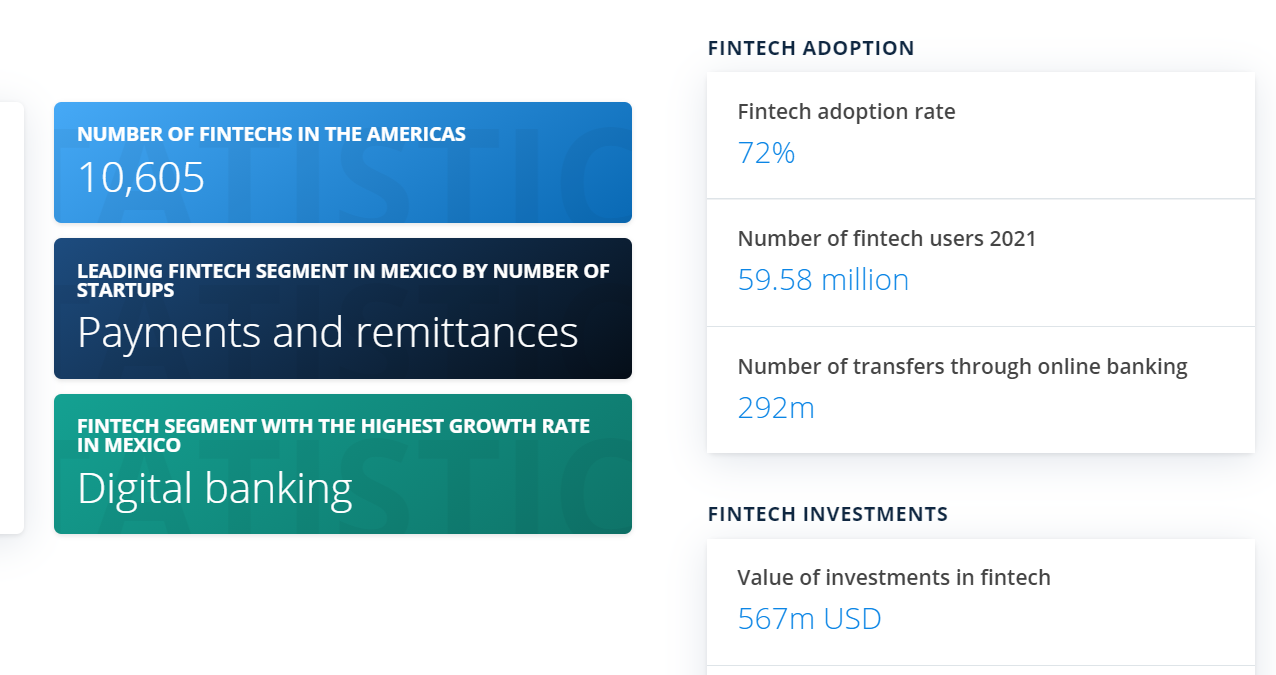
Growing a Startup in Mexico
Mexico continues to inspire and attract startups, investors, and businesspeople from around the globe. For example, as of February, 26,000 fintech companies exist worldwide and 40% reside in the Americas.
440 fintechs are in Mexico.
Mexican fintech, Clara, recently closed another successful round of funding. Operating out of Mexico City, Clara provides corporate cards to Mexican companies.

Clara is focusing on other startups within the Mexican market. Mexico City has the largest number of startups in Mexico. The spread among Mexican cities contrasts from Brazil (Sao Paulo hosts the majority of Brazilian startups).
As of April 2020, software/data and fintech accounted for more than half of all new businesses.
VCs Are Investing in Mexican Startups
VC investment in Mexican startups rose significantly from 2018 to 2019.

2020 investment in Latin American startups reached $4 billion. Divibank (founded during the pandemic) offers alternative funding to startups and has no problems attracting clients as well as investors.
Divibank recently closed a round of funding with Better Tomorrow Ventures, which sees Latin America as a “massive, untapped market.”
Startup, Homie, has received funds by offering a process that streamlines the leasing process, aligning landlord properties with ready and willing tenants.

Read more about Investing in Latin America
M-commerce Has Seen Great Growth
E-commerce and retail accounted for 23% of Mexico’s market. However, internet capabilities are limited for some residents throughout Mexico. Startup, Bridgefy, offers one solution. It utilizes mesh network technology to provide connectivity despite WiFi or data complexities.
It’s been used by web browsers around the world and has raised $1.5 million. Bridgefy enables browsing and internet purchasing while Bayonet helps e-commerce websites avoid fraud. Bayonet uses big data and AI to identify odd behavior, allowing vendors to avoid fraudulent purchases. Bayonet secured $500,000 in December from a range of investors.

Amazon is no stranger to Mexican shoppers. In 2018, it facilitated e-commerce in Mexico. Less than a third of Mexican citizens have credit cards. So, Amazon created debit cards, Amazon Rechargeable.
Amazon has additionally invested in Mexico, launching virtual assistant Alexa and opening a distribution center in Queretaro. The online marketplace in Mexico is expected to reach $14 billion by 2022.
Fintech Is the New Black
Mexican startup, Oyster, offering a smart wallet and debit card that allows workers to track funds, launched in 2019. Minu is another Mexican startup that helps workers by enabling employees to secure funds in a speedy fashion. Salary can be obtained before the end of the month, so cash is accessible based on prior hours worked.
Minu raised $6.5 million in one of Mexico’s largest pre-seed rounds. Minu takes care of earned wages, but what about Mexico’s ability to wage cryptocurrency? Enter Tala.
Tala, with the aid of Visa, makes it easier for underbanked consumers to exchange cryptocurrency. Those with digital wallets linked to Tala will be able to use Visa “cards” to access a network of merchants worldwide. Visa’s Head of Cryptocurrency sees potential throughout markets where traditional banking is lacking or places where consumers have few options in sending and receiving funds.
Tala’s CEO seeks to lower the cost of remittances. Cross-border transaction fees can exceed 6%. But, consider a service like Bitso (crypto platform used throughout Latin America), which only charges a currency conversion rate (with upper limit of 0.65%).

Currently, there’s a huge opportunity for brands that can support consumers who want to buy/sell/send money, especially across borders. New fintech brands and financial alternatives continue to rise. There’s an incredible surge in fintech IPOs – seven in the first four months of 2021.
In Mexico, internet use and commerce is high yet banking solutions are low. There’s HUGE potential for North American brands and others from around the globe.
Read more about Fintechs in Mexico
Crossing Borders of Business
Now’s the time to seize business opportunities. Mexico is ripe for e-commerce, real estate, fintech, and SaaS brands. While many native startups are rising there’s plenty of market share left.
Many US brands remain hesitant to invest in Latin America or make attempts to market in LatAm. However, the window of opportunity will close with the passing of time. What can brands do right now to grow a startup in Mexico?
Research Whether Your Startup Has Growth Opportunities
Clearly, plenty of opportunities remain for fintech solutions. Brands that can make it easier for Mexicans to send and receive funds. More brands will continue to experiment, providing digital wallets, debit cards, and methods of sending and receiving crypto currency.
Translate Marketing Messages from English to Spanish
Yet, startups don’t have the luxury of collective wisdom. If a startup owner has never been a part of translating web copy to create Hispanic ads, they’re unaware of how ineffectual translation can be.
For example, an advertising campaign needs to align with local culture and language. For, Spanish spoken in Mexico differs from that spoken in Brazil, Paraguay, Colombia, etc. Therefore, transcreation, the process of adapting messages to properly target a particular region and natives therein, is an optimal solution.
Read more about Spanish Translation vs Transcreation
Let’s discuss growing your startup in Mexico. It requires research and proper implementation of the language. We’ve helped other marketing agencies and companies of all kinds successfully penetrate Latin American markets. You’re next.
https://www.statista.com/statistics/877609/mexico-sector-startups/
https://www.statista.com/statistics/879291/value-venture-capital-investment-mexico
https://www.crunchbase.com/organization/homie-a45a
https://www.statista.com/topics/5277/fintech-in-mexico/





